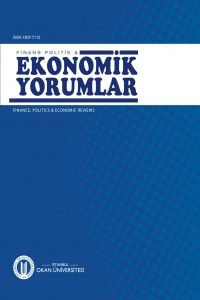Doğal Afet Risk Yönetiminde DünyaBankası Modeli
Doğal afetler, ölümlere, yaralanmalara ve/veya maddi hasar kayıplarına neden olan doğa olayları olarak tanımlanabilir. Doğal afetler literatürde sıklıkla ani, şiddetli, planlanmamış, doğrudan doğa olayları ile meydana gelenler(Otero, Marti, 1995:14) ya da insanların neden olduğu,tahmin edilebilir ve önlenebilir doğal afetler olarak sınıflandırılmaktadır(Manion, Evan 2001:6), (Steinberg, 2000:48.) Örneğin şiddetli yağışlar sonucu olan seller doğal afet kaynaklı iken, sığınmacı göçmenlerin kapasiteyi aşan şekilde botlarla ulaşımlarındaki batma-boğulma kazaları gibi doğal afetler, insan kaynaklıdırlar. Ancak doğal afetlerin neden oldukları hasarlar ve bu hasarların giderilmesinde izlenen risk yönetim yöntemleri ülkelere göre değişiklik göstermektedir. Bu bağlamda çalışmanın amacı doğal afet türlerine göre izlenen risk finansman yöntemlerini Dünya Bankası özelinde irdelemektir.
Anahtar Kelimeler:
Doğal Afetler, Doğal Afet Risk Yönetimi, Doğal Afetlerin Finansmanı, Dünya Bankası’nın Doğal Afet Finansman Teknikleri
World Bank's Natural Disaster Risk Financing Model
Natural disasters defineable as natural events whic is causing property damage losses, deaths and / or injuries. In the literature, Natural disasters are classified as direct natural events ,which is occurring with often sudden, severe, unplanned, and human-induced natural disasters(Otero, Marti, 1995:14), which are predictable and avoidable natural disasters (Manion, Evan 2001:6), (Steinberg, 2000: 48).For example, while floods caused by heavy rains induced natural disasters, natural disasters such as the sinking-drowning accidents of refugee immigrants in transport by boat in the way of the excess of boots transport capacity are human-induced. But the damage caused by natural disasters and followed risk management methods for the elimination of this damage varies according to the country. In this context, the purpose of the study is to examine the kinds of natural disaster risk financing methods of World Bank, which are followed according to the types of natural disasters.
Keywords:
Natural Disasters Natural Disasters Risk Management, Finance, Natural Disaster, The World Bank’s Natural Disaster Financing Techniques,
___
- Afet ve Acil Durum Yönetimi Başkanlığı (AFAD); (2013), Afet Risk Yönetimi, https://www.afad.gov.tr/dokuman/ tr/24092012162638.pdf, E.T. 23.10.2013, ss.1-8.
- BURNHAM,Gilbert; (2008), “Disaster Definitions”, Public Health Guide in Emergencies, Ed. Rand E., C., The Johns Hopkins and Red Cross International Federation of Red Cross
- and Red Crescent Societies (IFRC), http://www.jhsph.edu/ research/centers-and-institutes/center-for-refugee-and-disaster-response/publications_tools/publications/_CRDR_ICRC_ Public_Health_Guide_Book/Forward.pdf, Chapter 1, Second Edition , Switzerland , pp. 24-39.
- CABEZON, Ezequiel, HUNTER, Leni, TUMBARELLO, Patrizia, WASHİMİ, Kazuaki and WU, Yiqun;(2015), “Enhancing Macroeconomic Resilience to Natural Disasters and Climate Change in the Small States of the Pacific”, IMF working paper, https://www.imf.org/external/pubs/ft/wp/2015/wp15125. pdf, E.T. 23.03.2016, pp. 1-37.
- Child Fund International; (2013), The Devastating Impact of Natural Disasters, https://www.childfund.org/Content/NewsDetail/2147489272/, 02.06.2013, E.T. 20.03.2016.
- COPPOLA, Damon; (2015), Introduction to International Disaster Management, Third Edition, Elsevier. DEY, Balaka and SİNGH, Ram, B.; (2006),“Natural Hazards and Disaster Management”, Central Board of Secondary Education, http://cbse.nic.in/natural%20hazards%20&%20disaster%20management.pdf, Delhi, E.T. 24.03.2016, pp.1-45.
- East African Community (EAC); (2012), “Disaster Risk Reduction andManagement Strategy”(2012 – 2016),The Johns Hopkins and Red Cross International Federation of Red Cross and Red Crescent Societies (IFRC)http://www.ifrc.org/Global/ Publications/IDRL/regional/EAC_DRRMS(2012-2016).pdf, Eac SecretariatArusha, Tanzania, October, E.T., 21.03.2016, pp. 1-79.
- European Commission (EC); (2015),“Disaster Risk Management Echo FactSheet, Humanitarian Aid and Civil Protection”, http://ec.europa.eu/echo/files/aid/countries/factsheets/thematic/disaster_risk_management_en.pdf,E.T.20.03.2016, pp. 1-3.
- European Commission (EC); (2006), “Definitions of “Disaster” and “Crises” and Related Policies at Member State Level,”http://ec.europa.eu/agriculture/analysis/external/insurance/definitions_en.pdf, E.T.20.03.2016, pp.23-42.
- REVILLA, Fernando G.;(2015), “Humanitarian Health Action, Emergency and Disaster Risk Management for Health”, http://www.who.int/hac/techguidance/preparedness/en/, E.T. 25.03.2016.
- FERREİRA, Susana, HAMİLTON, Kirk and VİNCENT, Jeffrey; (2011),“Nature, Socioeconomics and Adaptation to Natural Disasters: New Evidence from Floods”, WB Working Paper Number 5725,http://www-wds.worldbank.org/external/default/ WDSContentServer/WDSP/IB/2011/06/30/000158349_201106 30170010/Rendered/PDF/WPS5725.pdf,E.T. 18.03.2016, pp. 1-49.
- FREEMAN, Paul K., MARTİN, A., Leslie, LİNNEROOTHBAYER, Joanne, MECHLER, Reinhard, PFLUG, Georg and WARNER, Koko; (2013).“Disaster Risk Management”, http://idbdocs.iadb.org/wsdocs/getdocument.aspx?docnum=36344547, Washington, August , pp.1-83.
- GÖZPINAR Esin; (2006), “Doğal Afetler, Kalkınmanın Önündeki Engeller”, TEPAV, http://www.tepav.org.tr/tur/admin/dosyabul/upload/dogalfelaketkalkinmaninonundekiengeller.pdf, 27.03.2016, pp. 1-20.
- KREFT, Sönke, ECKSTEİN, David, JUNGHANS, Lisa, KERESTAN, Candice and HAGEN, Ursula; (2015), “Global Climate Risk Index 2015”, Think&Thank Research, https://germanwatch.org/de/download/10333.pdf, E.T. 22 April 2015, pp.1-32.
- MAHUL, Olivier; (2011), World Bank Group Disaster Risk Financing & Insurance (DRFI) BusinessLines,https://www.gfdrr. org/sites/gfdrr.org/files/documents/DRFI_WBG_ProductLines_ Jan11.pdf, January, E.T. 23.03.2016,pp. 1-2
- ISSN: 1307-7112
- Başlangıç: 1963
- Yayıncı: İstanbul Okan Üniversitesi
Sayıdaki Diğer Makaleler
Harvey’in Mülksüzleştirme YoluylaBirikim Kavramına Eleştirel Bir Bakış:Türkiye Örneği
Göreceli Yoksunluk, Eşitsizlik ve Büyüme Üzerine Bir Modelleme
Doğal Afet Risk Yönetiminde DünyaBankası Modeli
Ekonomik Küreselleşme ve Büyüme İlişkisi: Türkiye Örneği Toda- Yamamoto Nedensellik Analizi
E7 Ülkelerinde Finansal Gelişme ve Ekonomik Büyüme Arasında Nedensellik Analizi
